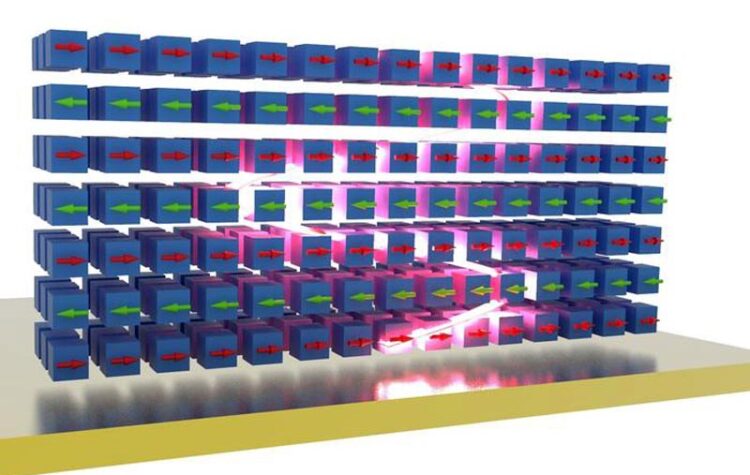CCNY scientists trap light inside a magnet

Light trapped inside a magnetic crystal can strongly enhance its magneto-optical interactions.
Image created by Rezlind Bushati / City College of New York
A new study led by Vinod M. Menon and his group at the City College of New York shows that trapping light inside magnetic materials may dramatically enhance their intrinsic properties. Strong optical responses of magnets are important for the development of magnetic lasers and magneto-optical memory devices, as well as for emerging quantum transduction applications.
In their new article in Nature, Menon and his team report the properties of a layered magnet that hosts strongly bound excitons — quasiparticles with particularly strong optical interactions. Because of that, the material is capable of trapping light — all by itself. As their experiments show, the optical responses of this material to magnetic phenomena are orders of magnitude stronger than those in typical magnets. “Since the light bounces back and forth inside the magnet, interactions are genuinely enhanced,” said Dr. Florian Dirnberger, the lead-author of the study. “To give an example, when we apply an external magnetic field the near-infrared reflection of light is altered so much, the material basically changes its color. That’s a pretty strong magneto-optic response.”
“Ordinarily, light does not respond so strongly to magnetism,” said Menon. “This is why technological applications based on magneto-optic effects often require the implementation of sensitive optical detection schemes.”
On how the advances can benefit ordinary people, study co-author Jiamin Quan said: “Technological applications of magnetic materials today are mostly related to magneto-electric phenomena. Given such strong interactions between magnetism and light, we can now hope to one day create magnetic lasers and may reconsider old concepts of optically controlled magnetic memory.” Rezlind Bushati, a graduate student in the Menon group, also contributed to the experimental work.
The study conducted in close collaboration with Andrea Alù and his group at CUNY Advanced Science Research Center is the result of a major international collaboration. Experiments conducted at CCNY and ASRC were complemented by measurements taken at the University of Washington in the group of Prof. Xiaodong Xu by Dr. Geoffrey Diederich. Theoretical support was provided by Dr. Akashdeep Kamra and Prof. Francisco J. Garcia-Vidal from the Universidad Autónoma de Madrid and Dr. Matthias Florian from the University of Michigan. The materials were grown by Prof. Zdenek Sofer and Kseniia Mosina at the UCT Prague and the project was further supported by Dr. Julian Klein at MIT. The work at CCNY was supported through the US Air Force Office of Scientific Research, the National Science Foundation (NSF) – Division of Materials Research, the NSF CREST IDEALS center, DARPA and the German Research Foundation.
Journal: Nature
Method of Research: Experimental study
Subject of Research: Not applicable
Article Title: Magneto-optics in a van der Waals magnet tuned by self-hybridized polaritons
Article Publication Date: 16-Aug-2023
All latest news from the category: Physics and Astronomy
This area deals with the fundamental laws and building blocks of nature and how they interact, the properties and the behavior of matter, and research into space and time and their structures.
innovations-report provides in-depth reports and articles on subjects such as astrophysics, laser technologies, nuclear, quantum, particle and solid-state physics, nanotechnologies, planetary research and findings (Mars, Venus) and developments related to the Hubble Telescope.
Newest articles

A ‘language’ for ML models to predict nanopore properties
A large number of 2D materials like graphene can have nanopores – small holes formed by missing atoms through which foreign substances can pass. The properties of these nanopores dictate many…

Clinically validated, wearable ultrasound patch
… for continuous blood pressure monitoring. A team of researchers at the University of California San Diego has developed a new and improved wearable ultrasound patch for continuous and noninvasive…

A new puzzle piece for string theory research
Dr. Ksenia Fedosova from the Cluster of Excellence Mathematics Münster, along with an international research team, has proven a conjecture in string theory that physicists had proposed regarding certain equations….



